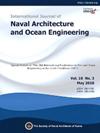Numerical and experimental study of the dynamic response of a wind-wave combined energy platform under WEC motion constraints
IF 3.9
3区 工程技术
Q2 ENGINEERING, MARINE
International Journal of Naval Architecture and Ocean Engineering
Pub Date : 2024-01-01
DOI:10.1016/j.ijnaoe.2024.100627
引用次数: 0
Abstract
The motion response of a wind–wave-combined energy platform with and without a wave energy converter (WEC) was analyzed using numerical simulations and wave tank experiments. The effects of the WEC power take-off (PTO) and WEC motion constraints on the motion response of the platform were also analyzed. The analyzed model consisted of cylindrical WECs attached to a spar-shaped floating offshore wind turbine (FOWT) from front to back. Numerical analysis was performed using a potential-flow-based hydrodynamic program (ANSYS AQWA) based on the boundary element method to perform time domain analysis. Nonlinear Froude–Krylov forces and hydrostatic forces were considered to improve the accuracy of the numerical results. The dynamic interactions between the FOWT and the mooring lines were considered. The numerical results showed good agreement with the experimental data. The pitch and heave of the combined platform were reduced significantly by the motion of the WEC attached to the FOWT. In particular, the rotational motion of the WEC had the greatest impact on the motion reduction of the platform. This effect helped reduce the mooring tension. On the other hand, the pitch response of the platform increased slightly when the WEC was fixed to the platform (no motion) or when a large PTO coefficient was applied.
WEC运动约束下风波联合能平台动力响应的数值与实验研究
采用数值模拟和波浪槽试验的方法,分析了带和不带波浪能转换器的风波联合能平台的运动响应。分析了WEC功率输出(PTO)和WEC运动约束对平台运动响应的影响。所分析的模型是由一个圆柱形的风力发电机(FOWT)由前到后连接到一个桅杆形的浮动海上风力发电机(FOWT)。采用基于边界元法的基于势流的水动力程序(ANSYS AQWA)进行数值分析。为了提高数值结果的精度,考虑了非线性弗劳德-克雷洛夫力和流体静力。考虑了系统与系泊索之间的动力相互作用。数值计算结果与实验数据吻合较好。连接在FOWT上的WEC运动显著降低了组合平台的俯仰和升沉。其中,WEC的旋转运动对平台运动减小的影响最大。这种效果有助于降低系泊张力。另一方面,当WEC固定在平台上(不运动)或施加较大的PTO系数时,平台的俯仰响应略有增加。
本文章由计算机程序翻译,如有差异,请以英文原文为准。
求助全文
约1分钟内获得全文
求助全文
来源期刊

International Journal of Naval Architecture and Ocean Engineering
ENGINEERING, MARINE-
CiteScore
4.90
自引率
4.50%
发文量
62
审稿时长
12 months
期刊介绍:
International Journal of Naval Architecture and Ocean Engineering provides a forum for engineers and scientists from a wide range of disciplines to present and discuss various phenomena in the utilization and preservation of ocean environment. Without being limited by the traditional categorization, it is encouraged to present advanced technology development and scientific research, as long as they are aimed for more and better human engagement with ocean environment. Topics include, but not limited to: marine hydrodynamics; structural mechanics; marine propulsion system; design methodology & practice; production technology; system dynamics & control; marine equipment technology; materials science; underwater acoustics; ocean remote sensing; and information technology related to ship and marine systems; ocean energy systems; marine environmental engineering; maritime safety engineering; polar & arctic engineering; coastal & port engineering; subsea engineering; and specialized watercraft engineering.
 求助内容:
求助内容: 应助结果提醒方式:
应助结果提醒方式:


